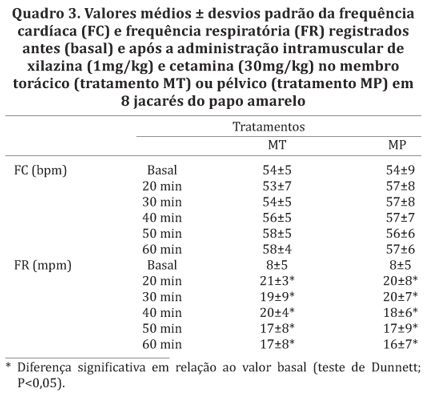Reptiles possess a renal portal system which can divert part of the blood from the caudal portions of the body to the kidney before it reaches the systemic circulation. In view of this, it has been recommended the administration of injectable medications in the forelimbs, in order to avoid immediate glomerular filtration, which might result in a reduction of the expected effect. The aim of this study was to compare qualitative and quantitative aspects of the pharmacological restraint provided by the combination of ketamine (30mg/kg) and xylazine (1mg/kg), injected into the forelimb or hindlimb, in broad-snouted caiman juveniles (Caiman latirostris). Eight male animals, with a mean weight (±SD) of 1.3 (±0.3) kg, and aged about 2 years old, were anesthetized on two separate occasions with an interval of 7 days. On each occasion, the animals were randomly assigned to receive the anesthetic combination intramuscularly into the forelimb (FL treatment) or hindlimb (HL treatment). The time intervals between administration of treatment and loss of the righting reflex (induction time), between the loss and return of this reflex (duration of important clinical effect), and between the return of the righting reflex and first movements of ambulation (duration of residual effect) were measured as well as heart and respiratory rates and cloacal and environmental temperatures. Sedation/anesthesia scores were evaluated using a scale ranging from 0 (alert/conscious) to 10 (deep anesthesia/overdose). In the HL treatment, loss of righting reflex was not observed in two animals. Considering only those animals whose loss of righting reflex was observed, the induction time (21±9 and 17±5 minutes), the duration of important clinical effect (35±19 and 43±21 minutes), and the duration of residual effect (28±31 and 12±11 minutes) were similar between the FL and HL treatments, respectively (mean±SD). Sedation/anesthesia scores were significantly higher than at baseline from 20 to 50 minutes in both treatments and, at 30 minutes (peak sedative effect), the median score (interquartile range) was 3.5(2.3-4.0) in the FL treatment and 3.0(2.0-4.0) in the HL treatment. Differences between treatments in physiological variables were not observed. In both treatments, withdrawal reflex in response to digital clamping was not absent at any timepoint. The administration of xylazine-ketamine combination in the forelimb or hindlimb of broad-snouted caiman juveniles provides similar effects, suggesting that the influence of the renal portal system is not clinically relevant. At the doses used, such combination does not induce surgical anesthesia and the immobility/pharmacological restraint is unpredictable and of short duration.
Renal portal system; ketamine; xylazine; dissociative anesthetics; alpha-2 agonists; chemical restraint; sedation; broad-snouted caiman; Caiman latirostris; crocodilians




